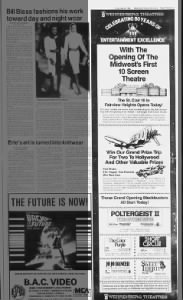General Cinema closed the cinema on October 5th, 2000, and Entertainment Film Works reopened it on September 7th, 2001, before being evicted for non-payment of rent on November 19th, 2002. Another ad posted.
This was renamed the Canton Centre Cinema I & II on May 26th, 1989. It was rebuilt and reopened with 8 screens on January 26th, 1990. Grand opening ads posted.
The Dreamland Theatre opened on October 7th, 1911. Grand opening ad posted.
The Vernon theater was opened by J. W. & W. J. Dusenbury on April 11th, 1914. Grand opening ad posted.
This opened as Empress on November 2nd, 1914 with Marcus Loew’s vaudeville. Grand opening ad posted.
This was renamed Lyceum on August 18th, 1914.
Grand opening ad posted.
Grand opening ad posted
Grand opening ad posted.
1973 grand opening ads for screens no. 3 & 4 posted.
Grand opening ad posted.
The High Street Theater opened on September 3rd, 1894. Grand opening ad posted.
Grand opening ad posted.
This opened on January 15th, 1999. Grand opening ad posted.
This was opened by Kerasotes on April 17th, 1998. Grand opening ad posted.
Grand opening ad: Wehrenberg St. Clair 10 opening 23 May 1986, Fri The Belleville News-Democrat (Belleville, Illinois) Newspapers.com
Wehrenberg St. Clair 10 opening 23 May 1986, Fri The Belleville News-Democrat (Belleville, Illinois) Newspapers.com
4 screens on November 8th, 1985. Grand opening ad posted.
General Cinema closed the cinema on October 5th, 2000, and Entertainment Film Works reopened it on September 7th, 2001, before being evicted for non-payment of rent on November 19th, 2002. Another ad posted.
Grand opening ad and picture posted.
Picture and Grand opening ad posted.
Grand opening ad and picture posted.
This opened on May 19th, 2005. Grand opening ad posted.
Closed in 1991 and reopened by Cinemark on April 2nd, 1993, as the Movies 4 - Hills Plaza showing discount movies. Grand opening ad posted.
Closed December 1st, 1992.
This was renamed the Canton Centre Cinema I & II on May 26th, 1989. It was rebuilt and reopened with 8 screens on January 26th, 1990. Grand opening ads posted.
Last season: 1988 per newspaper listings.
This was renamed as the Park Cinema on April 12th, 1985. Notice the Microsoft logo? Another ad posted.